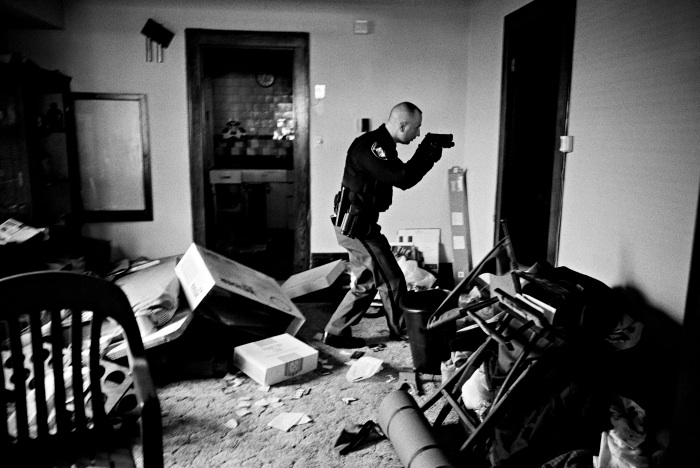
Anthony Suau © 2008
This image, taken by American photographer, Anthony Suau, won the World Press Photo of the Year 2008 award. The photograph was taken in March 2008 as part of a story commissioned by Time magazine. It depicts an armed officer of the Cuyahoga County Sheriff's Department moving through a house in Cleveland, Ohio following eviction as a result of mortgage foreclosure.
The announcement of the award was accompanied by statements by several of the judges. Mary Anne Golon, former picture editor of Time magazine and chair of the WPP jury stated: "Now war in its classic sense is coming into peoples' houses because they can't pay their mortgages." Golon's conflation of war and economic crisis may be viewed as clumsy, too readily universalizing the particularities of this image, but there is a connection.
Golon's comment that the photograph mimics 'classic' war imagery assumes that such imagery has a certain location- a sphere that is foreign, elsewhere, not domestic. This is a common assumption and one that Suau's image questions via its photojournalistic framing of a 'domestic' (American, home interior) scene. This is to say that the image has suggestive national and geopolitical frames of reference that are interlinked. They render the US as the locus of an economic crisis that is global in scope and was precipitated precisely by the mortgaging of American homes, such as this one, now foreclosed. In this sense, we might say we are looking at a primal scene of America's neoliberal disorder.
As the officer moves hesitantly toward the dark doorway, we might imagine the image is further suggestive of the insecurities and vulnerabilities in the US in the wake of 9/11 and under conditions of a perpetual war on terror. Such insecurity has particular American connotations, ideologically and materially manifested as the need for 'homeland security'. The image reminds us that meanings of 'home' have been symbolically and economically destabilized by international events instigated by the US but now beyond its control.
The war on terror and the financial crisis are complexly interwoven features of an unregulated globalization that has effectively dislocated established registers of empathic identification with the worlds of 'others'. Today, international landscapes of violence and despair are less securely framed as distant spaces. Perhaps this is what Suau's image most fundamentally signifies: the dislocation of photojournalism's relationship to its subject.
What a powerful photo. It's like watching an event unfold in slow motion. When looking at the photo I feel as if I am peeping on the drama, through a key hole.
Mimi Doran

